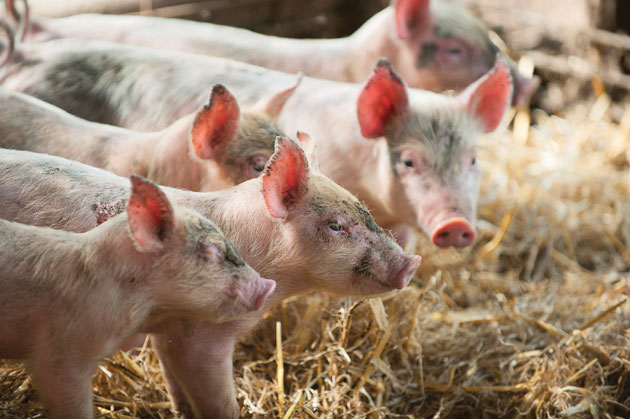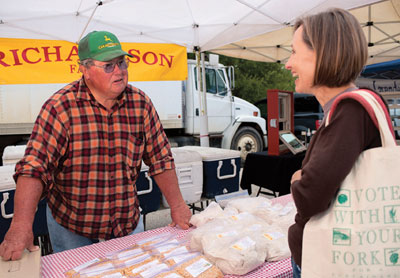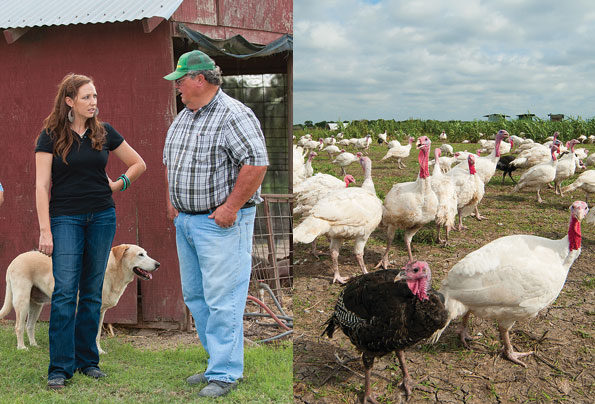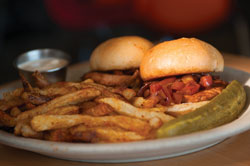
Photos by Mark Matson
Chef and artisan butcher Jesse Griffiths refuses to use anything but fresh, locally sourced ingredients in the gourmet dishes and old-style sausages he prepares for his Dai Due Butcher Shop and Supper Club in Austin, Texas. Calling him a selective shopper might be an understatement.
The grass-fed beef and pasture-raised pork produced by Dr. Jim Richardson and his wife, Kay, at Richardson Farms near Rockdale, Texas, more than meet Griffiths’ standards.
“I’ve purchased meat from the Richardsons since they had a little booth at an Austin farmers market,” Griffiths recalls. “When I talked with Jim for the first time about four years ago, I liked how he said he raised his animals. As their business grew, mine grew, too. Now I purchase a lot of my pork, beef and poultry from Richardson Farms.”
Since that initial meeting, Griffiths has toured the Richardsons’ operation twice and appreciates the couple’s farming ethics even more now. “Jim interacts with his pigs,” Jesse recalls. “Because he’s a veterinarian, he understands them. I really like that.”
Dai Due is among the 23 restaurants, eight delivery services and several groceries in the Austin area that purchase organically grown products from the Richardsons. Hundreds of individuals also have become loyal customers since meeting the couple at farmers markets.
“That’s how we started — satisfying one customer at a time and connecting with them at farmers markets,” Jim says. “They’re our bread and butter. We’ll always take care of them.”
Veterinarian First, Farmer Later
As a boy, Jim knew he wanted to be a farmer someday. But professionally, he didn’t start out as one.

Jim Richardson visits with a shopper at Barton Creek Farmer’s Market in Austin, Texas. On the table are bags of organic popcorn and flour.
“In the 1950s, I grew up helping my grandfather on his farm near Gainesville, Texas, and I loved it,” says Jim, who’s seated with Kay at their dining table at home on the farm. “I wanted my own someday, but I knew I’d need a job that would pay enough money so I could buy one. In high school, a veterinarian mentored me, and I’d go on calls with him. I loved animals, so I decided I could work as a veterinarian.”
After earning his degree from Texas A&M University, Jim worked for a mixed-animal practice in Bowie in north-central Texas. During their 25 years in Bowie, he and Kay, a registered nurse, raised three children and did some farming along the way, growing peaches, apples and melons, and direct-marketing their crops at farmers markets in Fort Worth.
In 1997, Jim sold his interest in the vet clinic, and he and Kay moved to Austin, where he joined a small-animal practice. A year or so later, they began searching for a farm within an easy drive of the city. “I knew as soon as I saw this property that I’d found my place,” he says. “Everything was in disrepair, but it had exactly what I wanted — good land and native trees.”
Financing Their Farm with Texas Land Bank
In the fall of 2000, the Richardsons bought the 197-acre farm with financing from Texas Land Bank. “We were fortunate to have their support,” Jim says. “And I love getting patronage dividends every year. That really
helps us a lot!
“The Land Bank was the first and only place we went for financing,” he adds. “We first heard about them through a neighbor in Bowie. That’s where our referrals come from, too — satisfied customers!”

Texas Land Bank Loan Officer Lyndi Sanders, left, meets with Jim Richardson. Far right: Free-range turkeys will be ready for market in November.
For nearly a year, the couple spent weekends at the farm, building fences, repairing buildings and planting 3,500 native trees, mainly oaks, while continuing to live and work full time in Austin. “We found out that we could grow them, but we couldn’t sell them very fast,” Kay says of the decade-old grove, which is still producing trees for sale.
Their first venture into commercial farming started with vegetables.
“We participated in a CSA (Community Supported Agriculture) and grew produce for customers who bought shares,” Jim says. “We did that for two years until we realized we weren’t making enough income to survive.”
“Plus, we’d harvest all those fresh vegetables, and then if they didn’t sell, we’d lose our products,” Kay adds.
That’s when the couple decided they’d go back to what Jim knew best — cows, pigs, chickens and turkeys.
Giving Customers What They Want
In the beginning, the Richardsons used chemical fertilizers on their farm. “I had that skill because, hey, I’m an Aggie,” he says. “But my customers were asking that we use only organic, chemical-free practices. We realized that there was a growing consumer demand for wholesome, homegrown products. So we listened.
“Now we farm without chemicals, and I’ve always taken compassionate care of my animals,” Jim says. “No, we’re not certified (organic), but I don’t have to pay someone to say we’re organic. Our customers can come to our farm and see what we do. They trust us, and they appreciate what we do.”
“When you become someone’s food producer, you develop strong bonds, and that’s rewarding,” Kay adds.
One such customer is Brenda Morris of Austin.
“I purchase about 90 percent of my groceries from local farmers like the Richardsons. The food is fresher, and having a relationship with my farmers is important to me,” Morris says. “I also appreciate how the Richardsons take good care of their animals.”
Beef, Pork, Chicken and Turkey
The Richardsons started living on the farm in 2004, but continued to commute to their Austin jobs. In 2007, they moved into their new home, which also was financed by Texas Land Bank, and over the next three years they both retired from their jobs to farm full time. Even before retiring, they began producing grass-fed, hormone-free beef, pork, chicken and turkey, all packaged and sold frozen.

Pork sliders from Kerbey Lane Cafe, one of 23 Austin-area eateries that feature the Richardson’s products.
“Pork is our forte — turkeys, too,” Jim says later, during a farm tour. “In Texas, there isn’t a lot of pork produced.” Their pork products include sweet Italian sausage, seven-bone roasts and pork tenderloins.
Wheeling his utility vehicle to a stop, he nods toward a shaded pen, where two dozen or so pigs are either dozing or nosing around in straw. “My pigs are happy,” Jim says.
“Animals should have the freedom to do whatever comes natural to them. If they’re in too close proximity of each other, they’ll get stressed and start attacking one another,” he explains.
Likewise, turkeys range free on pastures, while the chickens hunt and peck the pastures from within movable coops and houses. Cattle graze within electric-fenced paddocks that are rotated frequently so plants can rebound.
Six Farmers Markets Per Week
As the farm has grown, so has the work. A few years ago, son Mike, who lives in Bryan with his wife and stepson, joined his parents full time on the farm. Several relatives staff the family’s booths at six weekly farmers markets in Austin and Waco.
Jim applies much of what he learned on his grandfather’s 1950s-era farm, which didn’t use chemicals, either. He also incorporates practices used at Polyface Farm, a multigenerational, pasture-based operation in Staunton, Va.
“No we’re not certified, but I don’t have to pay someone to say we’re organic. Our customers can come to our farm and see what we do. They trust us, and they appreciate what we do.” – Dr. Jim Richardson
“About five years ago, I attended a field day on the farm,” says Jim, seated back at the dining table. “I wanted to see how a family farm makes a profit. One of the things I learned is if it fits into your scheme, grow whatever you can. Because when your customers trust you, they’ll buy your products.”
As a result, the Richardsons offer a large variety of packaged sausages and cuts of meat. “Pat Rabroker at the Hutto Westphalia Market processes all our meat,” Jim says. “We couldn’t do this without him. Pat knows how to do all the cuts that our customers request.”
The Richardsons also sell fresh-ground whole-wheat flour, heirloom cornmeal, gluten-free flour, popcorn, eggs and raw dog food. “My dogs are crazy about the Richardsons’ dog food,” Morris testifies. The couple even runs their own poultry-processing facility, which is inspected by the Texas Department of Health.
“The one thing we don’t do is milk cows,” Kay says.
“But I want to!” her husband exclaims. “I’d like a raw-milk dairy with 10 cows.”
Across the table, Kay smiles and shakes her head no. “I figure I won’t get one,” Jim sighs wistfully. “But I sure would love to have me a little herd of Jersey cows….”
“Dream on!” Kay says, laughing.
For more information, visit www.richardsonfarms.com.
The Richardsons’ All-Natural Farming Glossary
Dr. Jim Richardson practices a number of different techniques to achieve success on his chemical-free operation:
Conservation tillage
Any method of soil cultivation that leaves the previous year’s crop remains on the field.
“We plant in crop stubble with no-till equipment,” Jim says. “We believe the food web in the soil is a living thing with microbes and earthworms. If you plow that, you can kill it for five years. We use nature’s way of returning nutrients to the soil.”
Mob grazing
Refers to the short-duration, high-density grazing of small areas of pasture
“The objective is to get animals to travel all over the farm to help rebuild the farm’s soil,” Jim explains. “They’re putting nutrients back that have been mined extensively. The animals eat 40 percent and trample 60 percent. The manure they drop becomes fertilizer, and their hoofprints create pockets for seeds and moisture.
“We’re doing more than improving the land. We’re giving back to it.”
Chicken tractors and egg mobiles
Portable chicken coops without a floor
“Our broilers and laying hens are free range because they move every day to new grass and new forage,” Jim says. “We move the tractors and egg mobiles back and forth daily across alfalfa fields. The egg mobiles are actually recycled cotton trailers.”
Deep straw bedding
A Swedish pig production system designed to minimize animal stress
“Pigs need to root and lay down in water, sleep and wallow there,” Jim says. “They should do that without being in conditions that make them uncomfortable, like being too close to other pigs. We bed ours on hay, which collects the nutrients from their waste, and the pigs aerate the bedding, which produces rich compost for our fields.”